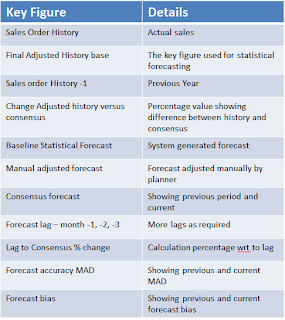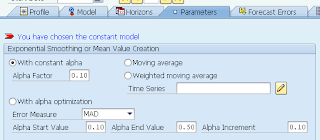• Supply chain pattern; make to order, make to stock, export markets, VMI ect..
• Product life cycle
• Proliferation of products
• Different roles in the business impacted by Demand Planning
SAP APO Demand Planning is one of the most un-structured solution in SAP; un-structured implies that the whole Demand Planning solution has to be built with the provided technical framework. It is purposely un-structured in that it has to be built to satisfy business requirements with respect to data views, data aggregation and data manipulation.
In order to effectively manage Demand Planning it is critical to understand the following:
• The technical framework
• Key elements in the technical framework
• The Demand Planning Process
DP TECHNICAL FRAMEWORK
This framework I provided standard in the APO Demand Planning system
This framewrok is provided by SAP to build the DP solution and consists of:
- Planning Area where data is stored and manipulated
- Planning book’s and data view; the user front end for managing Demand Planning. Characteristics and key figures. This is the most critical area for user management.
- Info Cube in the Data warehousing system needed for feeding data to the Demand Planning solution
The above must be
specifically set-up to satisfy the business requirements.
ELEMENTS IN THE
FRAMEWORK
Within the framework
there are additional elements provided by SAP DP framework, these are:
- Macro’s for manipulating data and presenting data in user friendly-way (example red cell for exception )
- Data aggregation management; critical for data viewing and data consistency
- Standard forecasting models
- Standard forecast error calculation formula
- Tool-set for phase-in, phase-out, interchangeability
- Characteristics based planning
- Ability to upload data back to Data warehousing info cube
- Ability to integrate Demand Planning data with other Supply Chain tools such as Supply network planning, production , Sales and Operations Planning
- Authorization control
- Exception and alert management
The above all play a
critical role in setting up an effective Demand Management solution and need to
be carefully addressed.
THE DEMAND PLANNING
PROCESS
The Demand Planning in
most cases consists of a number of steps, different resources, different data
granularity for each process, business and supply chain constraints. Therefore
critical to understand the process so that correct and effective Demand
Planning framework is set-up. In certain cases too much time is wasted in
addressing a forecasting formula or forecast accuracy formula instead of
understanding clearly the DP process. The understating of the process and
exploiting the technical framework ensure the correct level of user-friendliness
and desired objective.
The Demand Planning process consists
of:
- History Management or data preparation for actual forecasting process
- The actual forecasting and forecasting review process
- Consensus Management with different role players; marketing and sales , manufacturing
- Alert and exception management applicable to all three of the above process to ensure a more efficient data management. Critical for forecast accuracy, data manipulation (copying from one cell to another, mathematical calculation) and data presentation (red cell for phase pout period)
Furthermore the
process is controlled / constrained by organization procedure, market behaviors
and supply chain patterns.
The process is also
managed by different resource that require unique data granularity; consensus
forecasting with sales and marketing require data to be aggregated by brand, my
markets, channel ect..
Understanding the
above then determine how to exploit the provided framework.
HISTORY MANAGEMENT
The purpose of history
management is to provide clean base history data that will be the input to generating
the statistical forecast.
This data view must
show current and prior year demand such as shipment, order , promotional data .
The data view must
provide the level of detail needed to generate a fairly usable Adjusted History
Base. Marco’s will help to identify outliers for user to understand how to
address this aspect. Critical that user is able to view data by product
grouping, brand, markets ect..The macro’s must also clearly provide exceptions
allowing the user to prioritize their actions. Zero exception are also critical
for user to analyses and understand.
This data view is one
the most fundamental in that it provides the baseline data for statistical
forecasting. Forecast formula’s , forecast accuracy formula’s all become
irrelevant if the baseline is of little value.
This data view must
contain all the required data to manage the forecast by the planner. It must
provide required key figures that are needed for the planner to have clear view
on how the forecast should be managed.
It must clearly show how well forecast is
progressing and must provide all required data to manipulate and change
forecast models and factors. It must also provide historical forecast accuracy performance
data to indicate how well forecasting is progressing.
- It must have historical data for comparison purposes
- It must have forecast accuracy data to determine trends
- It must have alerts to efficiently manage exceptions with respect to forecast accuracy , outliers ect..
- It must allow focused data management; example flagging products that are phasing out and phasing in
- Monitoring and managing alpha, beta and gamma
The above is then
critical for the user to review forecast results, carry-out the necessary
changes such as changing the forecast model or
Additional key figures
that show bias values are also critical. These can help managed data with alert
threshold for planner to rapidly review forecast data.
CONSENSUS FORECASTING
Once forecasting is
completed, there is normally some form of consensus forecasting done with other
entities like sales and marketing , production.
Data aggregation is
critical when reviewing data with the specific business entity like marketing. Furthermore
not only is data aggregation critical but also time disaggregation.
Depending on target for consensus, it could be that both monthly and quarterly data will be required:
Monthly View
Quarterly View
This
is critical for data view and placing data granulality to suit the end target.
The data must be
specific and uncluttered with unnecessary data.
As shown above,
focused data for marketing review, data aggregation of data is critical; example
customer group, brand ect…, and must clearly control how data at lower level is
re-determined.
LEAN VIEWS:
Depending on target,
helpful to have multiple data view including lean views. Lean views mean that only
have basic data containing limited key figures at aggregated view. Example would
be reviewing data with marketing team, different data elements when reviewing
data with manufacturing.
The above defines the minimum data
needed to review data with specific business entity.
ALERT MANAGEMENT
The process needs to
be supported by robust alert and exception management to help relevant planner to
address specific data results. Alert must be process relevant.
Macro’s play a key
role in managing alerts in the relevant data view. Sometimes alerts have to
redetermine certain forecast error calculation. Typical consideration:
The mean
absolute percentage error (MAPE), also known as mean absolute percentage
deviation (MAPD), is a measure of accuracy of a method for constructing
fitted time series values in statistics, specifically in trend estimation
usually expresses accuracy as a percentage, and is defined by the formula:
Although the
concept of MAPE sounds very simple and convincing, it has a major drawbacks in
practical application ; If there are zero values (which sometimes happens for
example in demand series) there will be a division by zero. This is an area
where a custom macro could help to build own logic. Note; SAP provides standard
macro function, but nothing stops one from creating totally new function
(custom function module) with own logic.



















1 comment:
Very informative! This article really clarifies the importance of demand planning models in accurate forecasting. Looking forward to learning more about how businesses can leverage these models for better results.
Post a Comment